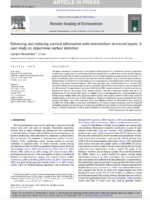ESF Researchers Explore New Technologies for Hydrology with CARTI Grant from SyracuseCoE
 Read the publication: Enhancing and replacing spectral information with intermediate structural inputs: A case study on impervious surface detection
Read the publication: Enhancing and replacing spectral information with intermediate structural inputs: A case study on impervious surface detection
As urban development continues to expand outward, cities and suburbs are losing permeable surfaces to sidewalks, roads, and parking lots. By taking natural hydrology out of the equation, we are faced with negative impacts on water quality from storm water runoff.
Runoff moves swiftly over impervious surfaces, picking up dirt and contaminants as it flows to the nearest water body. Runoff also puts pressure on sewer lines, which can breach capacity during storms, releasing a mixture of raw sewage and runoff directly into a nearby waterway before reaching a plant for treatment—known as combined sewer overflows.
Recently, researchers have been incorporating remotely sensed satellite imagery to detect impervious surface cover in a given area. The resulting maps help hydrologists link water quality to trends in development and nonpoint source water pollution (runoff). However, traditional hydrologic modeling methods are limiting because they capture total impervious surface cover but ignore its spatial distribution. Also, hydrologists are not aware of possible limitations in the image analysis algorithms that provide the impervious maps.
With funding support from SyracuseCoE, a team of researchers at the SUNY College of Environmental Science and Forestry has developed enhanced image processing technology capable of accurately detecting impervious surfaces, while simultaneously providing an accuracy metric for every detected pixel. The technology is revolutionary, as it bridges a significant scientific gap between image analysts and hydrologic modelers. Dr. Giorgos Mountrakis, an Assistant Professor in the Environmental Resources Engineering Department of SUNY ESF and the Principal Investigator in this grant, notes:
This enhanced processing technology is coupled with an integrated modeling framework that incorporates socioeconomic, land use and environmental monitoring data. These inputs can be plugged into the model and used to project future trends on a more frequent basis.
Moving forward, the model will be translated into software and distributed to communities to help them make smarter land-use decisions in the future.
